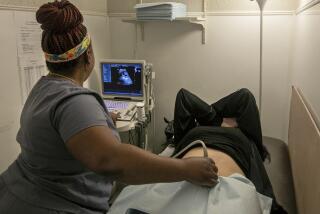Fetal Genetic Screening Test Fulfilling Earlier Promise
- Share via
In 1984, when researchers first introduced a new fetal genetic screening test called chorionic villi sampling, which can be done earlier and more quickly than amniocentesis, advocates urged caution among women and doctors attracted to the new technique.
Caution was suggested because, like any new procedure with significant potential public appeal, chorionic villi sampling had not been tested thoroughly enough to justify mass use. Inevitably, it attracted wide publicity and, though most news media urged caution among pregnant women, the few hospitals that offered it almost immediately experienced a heavy demand.
Three years later, researchers are starting to agree that the long-range tests necessary to make chorionic villi sampling a routine part of prenatal screening have been satisfactorily completed and that the procedure can take its place in widespread medical practice. The latest verification comes in a study of 100 pregnancies subjected to chorionic villi screening in England; it was reported in the journal Lancet.
In the new study, researchers found the technique accurate and safe, concluding that the method “will fulfill its theoretical and early promise.”
The testing method relies on using a needle to recover a tissue sample from the chorion, one of the outer fetal membranes, as opposed to the amnion, the innermost of the membranes. The chorion can be explored during the first trimester of a pregnancy and the test can be read and interpreted in just a few days, as opposed to the two or three weeks required for amniocentesis.
Herpes by Hickey
The AIDS crisis may have reduced concern over herpes to a more appropriate level than the panic it induced several years ago, but researchers in Virginia have now discovered a novel way herpes can be transmitted: by the love bites commonly called hickeys.
Reporting this development in a letter to the editor in the New England Journal of Medicine, two physicians in Norfolk and Portsmouth, Va., described the case of a 22-year-old man who sought treatment because of swelling and redness that persisted several days after a girlfriend gave him a hickey on his neck. The woman was undergoing a herpes outbreak at the time.
Laboratory analysis confirmed that the young man with the hickey had gotten herpes through this rather unexpected route. The possibility of a hickey-herpes connection joins earlier discoveries of unusual ways the disease can be spread, including through breast milk. Wrestlers can give one another herpes by skin contact during a match or even rubbing against a protective mat moist with perspiration from someone who has the disease.
Now, there is this embarrassing new problem too. Concluded the researchers: “Even hickeys are not totally innocuous.”
Racket-Game Eye Safety
For some time, eye experts have been urging participants in racquetball and squash to get serious about wearing well-designed eye guards, and cautioning that many popular protectors are ineffective and a waste of money. Now, in a new evaluation of racquet-sport eye-protection devices, Canadian experts have identified eight safe goggle brands.
The University of Toronto tests that led to the conclusions used a special gun to fire racquetballs and squash balls at a dummy head wearing different types of goggles. Eye guards with open slits in the middle and with no lenses--the most popular type--were consistently unable to keep the ball from striking the simulated eye. Protectors consisting of a frame with separate lenses in the middle were also ineffective.
Racquetballs travel at up to 110 m.p.h.; squash balls have been clocked at 140. Racquetball is played by 10 million Americans and squash by 1 million.
Only eye protectors made of polycarbonate plastic, molded in one piece, were safe. The brands that passed the test were: Action Eyes (Viking Sports, San Jose); Albany and New Yorker (LST Leader Sports Products, Inc., Essex, N.Y.); CRS 300 (CRS Sports International, Edmonton, Canada); Defender 600 (Peepers International, New York City); Safe-T-Eye Guard (Embassy Creations, Holmes, Pa.; Sports Scanner (American Optical, Southbridge, Mass.), and REP II (Ektelon, Inc., San Diego).
Body Clock and Births
Medical researchers have known for some time that there is an apparent relationship between the cycles of the so-called body clock and the onset of labor--with most studies indicating labor is most likely to begin somewhere between 1:30 a.m. to 3 a.m.
Now, a similar body-clock relationship has been discovered between the wee hours and the incidence of premature rupture of the fetal membranes--a complication that can lead to infection, premature birth or other problems. Both phenomena involve the body’s circadian rhythm--the clock-like mechanism that regulates a wide variety of human functions.
Not surprisingly, the prevailing time for rupture of the membranes in full-term pregnancies is similar to earlier findings about the onset of labor: 2:15 a.m. to 4 a.m. The conclusion, published in the journal Obstetrics and Gynecology, was reached by a research team at the University of Missouri School of Medicine.
There seemed to be differences between the time of premature membrane rupture and whether a woman was delivering at term or early. A logical explanation, the researchers said, is that the circadian mechanism is responsible.






